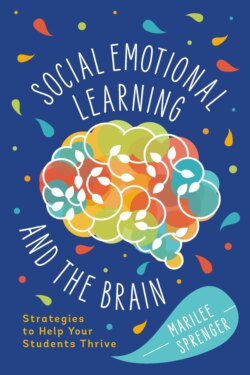Читать книгу Social-Emotional Learning and the Brain - Marilee Sprenger B. - Страница 8
Brain Structures and Chemicals Related to SEL
ОглавлениеOne of the simpler ways to look at the brain is from the bottom to the top. The spinal cord is connected to the brain stem, the lowermost part of the brain. The brain stem contains the first filtering system for information that comes into the brain via our senses. This system is called the reticular activating system, or RAS; it filters out about 99 percent of incoming information. If the information entering is in some way threatening, the RAS may halt the flow of information in favor of sending out an alarm throughout the brain. When the next level, the limbic system, receives the alarm, many activities begin. First, the amygdala, the brain's second filter, examines the information. The hypothalamus, which is part of the limbic system, sends out chemicals to prepare the body and brain for a fight-or-flight response. Other chemicals, such as adrenaline, which is released from the adrenal glands, cause the heart to beat faster and increase the rate of breathing. Unless the body is in immediate danger, whatever the stressor is, the thinking brain should decide what next steps to take. But the pathway from the thinking brain (the frontal lobe; in particular, the prefrontal cortex) down to the reflexive brain (the limbic system and the brain stem) is slow. If we put all our focus on the amygdala, the limbic structure in charge of emotions, it will (along with the hippocampus, a structure related to memory) bring to mind all the horrors of this particular stress-inducing phenomenon. For example, if we are approaching a large German shepherd and previously had a bad experience with a similar dog, that memory will drive our brain and we will expect a repetition of the bad incident.
Emotions influence where new information is processed in the brain. For learning to become memory, it must be directed through the emotional filter (the amygdala) along the route to the reflective, higher brain—the prefrontal cortex. When this happens, the brain takes a responsible look at the situation and finds a better way to handle it. Perhaps, in the German shepherd example, the thinking brain will notice that this dog is on a leash and would be unable to reach us.
Several chemical "cocktails" run our brains. Neurotransmitters such as dopamine, serotonin, endorphins, and oxytocin are some of the most common. Cortisol, the stress hormone, is also involved in many situations, both positive and negative. Cortisol is released when we are a little anxious about a presentation, an interview, or meeting someone for the first time—examples of good stress. It is also released when our brains are preparing for survival. That fight, flight, or freeze situation—bad stress—prompts the release of much more cortisol.
And what is the antidote to stress? According to Foreman (2019), the antidote is trust.
I have created the word selebrate to define the premise of my work. Selebrate stands for "social-emotional learning elicits brain responses appropriate to experience." It's a lot to say, but it says a lot. Social-emotional learning should help our students choose the appropriate response in whatever situation they may find themselves. Neuroscience researchers have found areas and chemicals in the brain that respond to certain learning strategies. I want us to be able to understand why a response occurs and then create more strategies that will engage the same areas of the brain.
